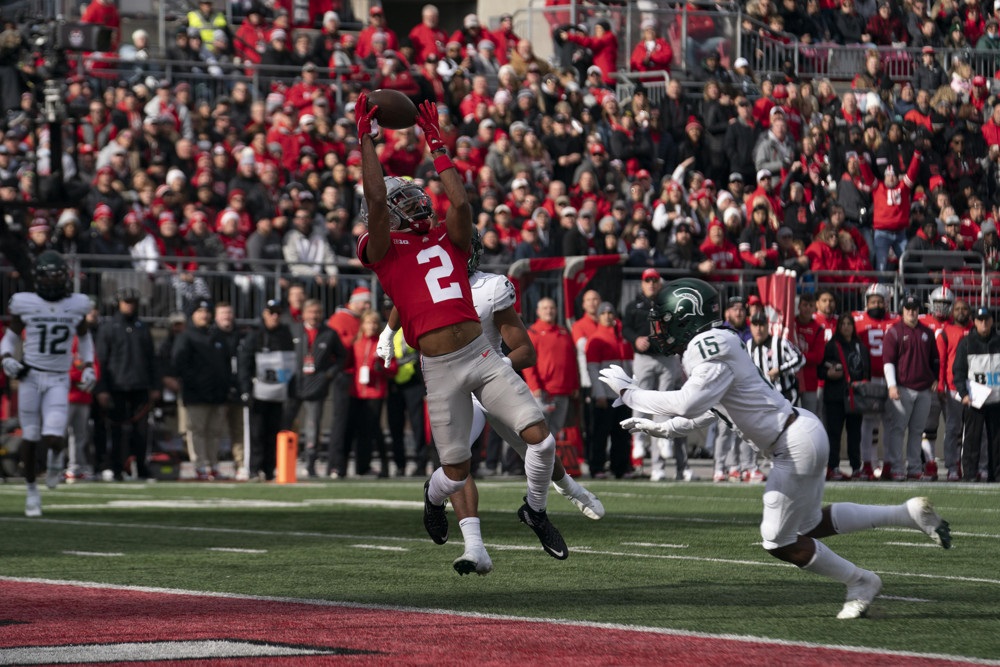Photo: Zacbon Durant/Icon Sportswire
It is easy to see why Colston Loveland was the first draft pick of the Ben Johnson era in Chicago. He is a lengthy TE with enough athleticism to cause mismatches all over the field. Adding Loveland to a skill group of DJ Moore, Rome Odunze, and D’Andre Swift creates endless possibilities for Johnson to create advantageous looks for Caleb Williams.
What Loveland Brings
Loveland possesses a lot of traits to excel in the NFL. Our NFL Draft scouting report describes him as an aggressive blocker and powerful receiver who seeks to win on every play. His experience in a pro-style offense makes it easy to see how he will translate to the next level. Recently, we compared Loveland to fellow 1st round TE Tyler Warren. At the end of the article, there is a great graphic showing the completeness of Loveland’s game not only as a receiver, but as a blocker, too.
Bears tight ends ranked 26th with 4 receiving Total Points* last season. To fit Ben Johnson’s style of offense, the Bears needed an injection of talent to the room. Cole Kmet is a fine blocker, but he has not become a presence in the passing game like expected.
* Total Points is our all-encompassing player value metric that attempts to capture everything that happens during a play. You can read about it here or watch a short video about it here.
How He Fits With What Ben Johnson Did In Detroit
The Lions added a dynamic, young TE in Sam Laporta before Johnson’s first full season as offensive coordinator. Loveland offers more of a natural downfield receiving threat while being less dynamic with the ball in his hands. The Loveland/Kmet duo is similar to the Laporta/Brock Wright pairing Johnson had in Detroit. Kmet, akin to Wright, is a better blocker while Loveland, akin to Laporta, brings the mismatch and receiving ability.
Johnson utilized 12 personnel (1 RB, 2 TE, 2 WR) at a high rate in Detroit, even doubling down on it last season to quite a bit of success. The table below highlights the usage and impact of 2 TE sets in Johnson’s offenses, compared to what the Bears put out there:
| 2023 Lions | 2024 Lions | 2024 Bears | |
| 12 Personnel% | 22% (13th) | 38% (2nd) | 19% (20th) |
| 12 Personnel Success Rate | 52% (2nd) | 49% (6th) | 36% (32nd) |
The Bears were a disaster in 12 personnel last year, ranking last in success rate. That is an area where Johnson clearly wanted to address as 12P was a staple of his offenses in Detroit. Pairing Loveland and Cole Kmet together will allow Johnson to deploy each player to his strengths.
Kmet established himself as a top blocking TE last season, finishing fifth at the position with 12 Blocking Total Points. This will take the pressure off Loveland and he can add strength and grow as a blocker, all while allowing Johnson to get creative with formations to attack defenses based on how they counter. He can line up both tight ends attached to the line of scrimmage and pound the rock against nickel defenses or split Loveland out wide against base defenses to create a mismatch against a linebacker or safety. The possibilities are endless for an offensive mastermind like Johnson.
Johnson and the Lions had a lot of success throwing over the middle of the field, partly due to Jared Goff’s skills. Johnson will tweak his offense to fit Caleb Williams’ skills and preferences, but we can expect Johnson to continue finding creative ways to access the middle of the field.
The table below shows the stats for Goff and Williams when throwing between the numbers during the 2024 season:
Throwing Between The Numbers
| Jared Goff | Caleb Williams | |
| Attempts | 336 | 269 |
| On-Target% | 81% | 77% |
| IQR* | 114.0 | 96.4 |
| Success% | 62% | 55% |
| Total Points per att | 0.23 | 0.23 |
* IQR (Independent Quarterback Rating) is an adjusted version of the traditional Passer Rating that emphasizes competitive throws and removes factors outside the passer’s control, like dropped passes.
As you can see, Goff did a lot more damage over the middle than Williams, but on a per-play basis Williams held his own when you focus on his contributions. The addition of Loveland should help as his frame offers a big, reliable target over the middle. On in-breaking routes (digs, posts, slants, crossing routes), his yards per route run (YPRR) was 3.5 in 2024, compared to 2.9 on all routes. Laporta had a 2.6 YPRR along with 11 Total Points on these in-breaking routes in his rookie season with Johnson. Expect Loveland to have a similar impact in his rookie season.
Another area where Loveland’s addition should elevate their offense is his ability to help Williams on broken plays. Loveland accumulated 4 Total Points on broken plays in 2023 with JJ McCarthy as his QB. This is an area where Williams struggled last year despite his success off-script in college. Williams ranked 8th in broken play attempts last year but 18th in Total Points per play, suggesting there is ample room for growth.
Summing it up
Loveland to the Bears is a perfect match. His skillset will allow him to play early while landing in a situation where he can improve on his weaknesses without them getting exposed. Kmet and his blocking skills will allow Loveland to add strength before he becomes the main guy at the point of attack. Johnson’s creativity will generate Loveland free releases and leverage advantages while he refines his separation abilities.
The Bears not only added a top talent in the draft, but at a position that will allow Ben Johnson to use 12P to the extent he did in Detroit. The Bears have brought in plenty of reinforcements to help Williams reach his full potential. Securing Loveland after fortifying the interior offensive line in free agency is the cherry on top.


